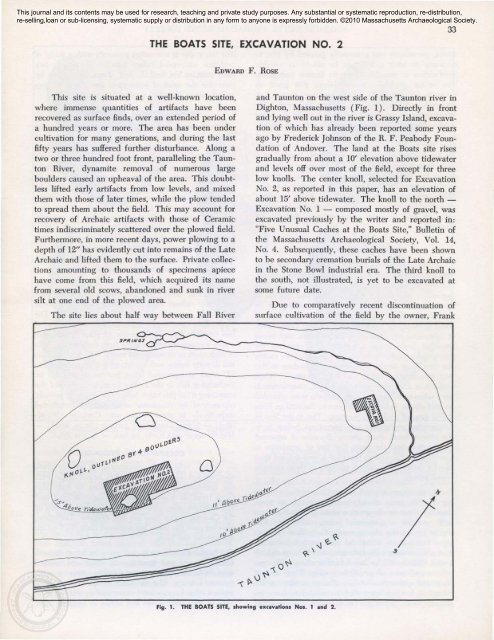An Impelling Force in Research (Editorial), 26(3-4)
An Impelling Force in Research (Editorial), 26(3-4)
An Impelling Force in Research (Editorial), 26(3-4)
You also want an ePaper? Increase the reach of your titles
YUMPU automatically turns print PDFs into web optimized ePapers that Google loves.
This journal and its contents may be used for research, teach<strong>in</strong>g and private study purposes. <strong>An</strong>y substantial or systematic reproduction, re-distribution,<br />
re-sell<strong>in</strong>g,loan or sub-licens<strong>in</strong>g, systematic supply or distribution <strong>in</strong> any form to anyone is expressly forbidden. ©2010 Massachusetts Archaeological Society.<br />
This site is situated at a well-known location,<br />
where immense quantities of artifacts have been<br />
recovered as surface f<strong>in</strong>ds, over an extended period of<br />
a hundred years or more. The area has been under<br />
cultivation for many generations, and dur<strong>in</strong>g the last<br />
fifty years has suffered further disturbance. Along a<br />
two or three hundred foot front, parallel<strong>in</strong>g the Taunton<br />
River, dynamite removal of numerous large<br />
boulders caused an upheaval of the area. This doubtless<br />
lifted early artifacts from low levels, and mixed<br />
them with those of later times, while the plow tended<br />
to spread them about the field. This may account for<br />
recovery of Archaic artifacts with those of Ceramic<br />
times <strong>in</strong>discrim<strong>in</strong>ately scattered over the plowed field.<br />
Furthermore, <strong>in</strong> more recent days, power plow<strong>in</strong>g to a<br />
depth of 12" has evidently cut <strong>in</strong>to rema<strong>in</strong>s of the Late<br />
Archaic and lifted them to the surface. Private collections<br />
amount<strong>in</strong>g to thousands of specimens apiece<br />
have come from this field, which acquired its name<br />
from several old scows, abandoned and sunk <strong>in</strong> river<br />
silt at one end of the plowed area.<br />
The site lies about half way between Fall River<br />
a<br />
THE BOATS SITE, EXCAVATION NO. 2<br />
EDWARD F. ROSE<br />
Fig. 1. THE BOATS SITE, show<strong>in</strong>g excavations Nos. 1 and 2.<br />
33<br />
and Taunton on the west side of the Taunton river <strong>in</strong><br />
Dighton, Massachusetts (Fig. 1). Directly <strong>in</strong> front<br />
and ly<strong>in</strong>g well out <strong>in</strong> the river is Grassy Island, excavation<br />
of which has already been reported some years<br />
ago by Frederick Johnson of the R. F. Peabody Foundation<br />
of <strong>An</strong>dover. The land at the Boats site rises<br />
gradually from about a 10' elevation above tidewater<br />
and levels off over most of the field, except for three<br />
low knolls. The center knoll, selected for Excavation<br />
No.2, as reported <strong>in</strong> this paper, has an elevation of<br />
about 15' above tidewater. The knoll to the north <br />
Excavation No.1 - composed mostly of gravel, was<br />
excavated previously by the writer and reported <strong>in</strong>:<br />
"Five Unusual Caches at the Boats Site," Bullet<strong>in</strong> of<br />
the Massachusetts Archaeological Society, Vol. 14,<br />
No.4. Subsequently, these caches have been shown<br />
to be secondary cremation burials of the Late Archaic<br />
<strong>in</strong> the Stone Bowl <strong>in</strong>dustrial era. The third knoll to<br />
the south, not illustrated, is yet to be excavated at<br />
some future date.<br />
Due to comparatively recent discont<strong>in</strong>uation of<br />
surface cultivation of the field by the owner, Frank

















